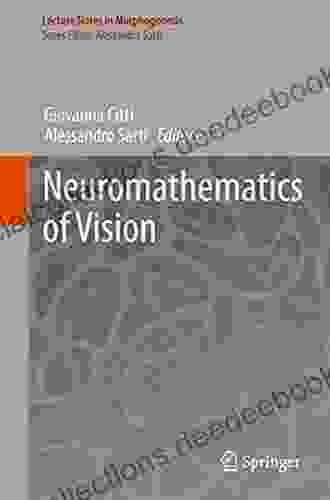Neuromathematics Of Vision Lecture Notes In Morphogenesis

Neuromathematics of vision lecture notes in morphogenesis is a field that investigates the mathematical principles underlying the development and function of the visual system. This field draws on a variety of disciplines, including neuroscience, mathematics, and computer science, to develop models and theories that can explain how the brain processes and interprets visual information.
5 out of 5
| Language | : | English |
| File size | : | 35363 KB |
| Screen Reader | : | Supported |
| Print length | : | 385 pages |
The visual system is a complex and intricate network of neurons and synapses that allows us to perceive the world around us. The development of the visual system begins in the womb, and continues throughout childhood and adolescence. During this time, the brain undergoes a series of changes that allow it to process and interpret visual information more efficiently.
One of the most important changes that occurs in the developing visual system is the formation of the primary visual cortex. The primary visual cortex is located in the occipital lobe of the brain, and it is responsible for processing visual information from the eyes. The primary visual cortex is organized into a series of columns, each of which is responsible for processing a specific type of visual information, such as color, shape, or motion.
The development of the primary visual cortex is a complex process that involves a number of different factors, including genetics, experience, and the environment. Genes play a role in determining the basic structure of the primary visual cortex, but experience and the environment can also influence the development of this region of the brain. For example, studies have shown that people who grow up in environments that are rich in visual stimulation have a more developed primary visual cortex than people who grow up in environments that are less visually stimulating.
The development of the visual system is a fascinating and complex process. By understanding the mathematical principles underlying this process, we can gain a better understanding of how the brain works and how we perceive the world around us.
The Mathematical Principles Of Vision
The mathematical principles of vision are based on the laws of optics. Optics is the study of light and its interactions with matter. The laws of optics can be used to explain how light travels through the eye and how it is processed by the brain.
One of the most important laws of optics is the law of refraction. The law of refraction states that when light passes from one medium to another, it bends. The amount of bending depends on the wavelength of the light and the refractive indices of the two media.
The refractive index of a medium is a measure of how much light is slowed down when it passes through that medium. The refractive index of air is 1.000, and the refractive index of water is 1.333. This means that light travels more slowly through water than it does through air.
When light passes from air into water, it bends towards the normal. The normal is a line perpendicular to the surface of the water. The angle at which the light bends is determined by the refractive indices of the two media.
The law of refraction can be used to explain how light travels through the eye. The cornea, which is the clear outer layer of the eye, has a refractive index of 1.377. The lens of the eye has a refractive index of 1.437. When light passes from air into the cornea, it bends towards the normal. When light passes from the cornea into the lens, it bends again towards the normal. This bending of light allows the eye to focus on objects at different distances.
The retina, which is the light-sensitive tissue at the back of the eye, contains millions of photoreceptors. Photoreceptors are cells that convert light into electrical signals. The electrical signals are then sent to the brain via the optic nerve.
The brain uses the information from the photoreceptors to create a visual image of the world. The visual image is processed by a number of different brain regions, including the primary visual cortex. The primary visual cortex is responsible for processing visual information from the eyes. The primary visual cortex is organized into a series of columns, each of which is responsible for processing a specific type of visual information, such as color, shape, or motion.
The development of the visual system is a complex process that involves a number of different factors, including genetics, experience, and the environment. Genes play a role in determining the basic structure of the visual system, but experience and the environment can also influence the development of this region of the brain. For example, studies have shown that people who grow up in environments that are rich in visual stimulation have a more developed visual system than people who grow up in environments that are less visually stimulating.
The Neuromathematics Of Vision
The neuromathematics of vision is a field that investigates the mathematical principles underlying the development and function of the visual system. This field draws on a variety of disciplines, including neuroscience, mathematics, and computer science, to develop models and theories that can explain how the brain processes and interprets visual information.
One of the most important areas of research in the neuromathematics of vision is the development of computational models of the visual system. These models can be used to simulate the activity of the visual system and to test hypotheses about how the brain processes visual information.
Computational models of the visual system have been used to investigate a variety of topics, including the development of the primary visual cortex, the processing of visual information in the brain, and the perception of visual illusions. These models have provided valuable insights into the workings of the visual system and have helped to advance our understanding of how we perceive the world around us.
The neuromathematics of vision is a relatively new field, but it is rapidly growing. As new computational tools and techniques are developed, we can expect to gain a deeper understanding of the mathematical principles underlying the development and function of the visual system.
The neuromathematics of vision is a fascinating and complex field that is rapidly growing. By understanding the mathematical principles underlying the development and function of the visual system, we can gain a better understanding of how the brain works and how we perceive the world around us.
5 out of 5
| Language | : | English |
| File size | : | 35363 KB |
| Screen Reader | : | Supported |
| Print length | : | 385 pages |
Do you want to contribute by writing guest posts on this blog?
Please contact us and send us a resume of previous articles that you have written.
 Book
Book Page
Page Chapter
Chapter Story
Story Genre
Genre Reader
Reader Library
Library Paperback
Paperback Magazine
Magazine Paragraph
Paragraph Sentence
Sentence Bookmark
Bookmark Foreword
Foreword Preface
Preface Footnote
Footnote Scroll
Scroll Tome
Tome Narrative
Narrative Autobiography
Autobiography Reference
Reference Thesaurus
Thesaurus Narrator
Narrator Character
Character Resolution
Resolution Librarian
Librarian Stacks
Stacks Archives
Archives Study
Study Research
Research Lending
Lending Reserve
Reserve Journals
Journals Reading Room
Reading Room Interlibrary
Interlibrary Study Group
Study Group Thesis
Thesis Dissertation
Dissertation Storytelling
Storytelling Theory
Theory Textbooks
Textbooks Gina Azzi
Gina Azzi Dr Guy Roberts
Dr Guy Roberts Eric Derise
Eric Derise Rob Ansell
Rob Ansell James Kirkpatrick
James Kirkpatrick Kye Si Kwon
Kye Si Kwon Lee M S
Lee M S Kerry Nenn
Kerry Nenn Erosa Knowles
Erosa Knowles Michael Morpurgo
Michael Morpurgo Terry D Turchie
Terry D Turchie Robert A Cutietta
Robert A Cutietta David Lafferty
David Lafferty Jane Dobisz
Jane Dobisz Judith Keim
Judith Keim Kourtney Jason
Kourtney Jason Aaron Good
Aaron Good William Edgar
William Edgar Adam Green
Adam Green Luca Tosi
Luca Tosi
Light bulbAdvertise smarter! Our strategic ad space ensures maximum exposure. Reserve your spot today!

 Ryan FosterConductor's Guide to Selected Baroque Choral-Orchestral Works: Understanding...
Ryan FosterConductor's Guide to Selected Baroque Choral-Orchestral Works: Understanding...
 Gerald BellThe One Year Women Friendship Devotional: A Deep Dive into True and Enduring...
Gerald BellThe One Year Women Friendship Devotional: A Deep Dive into True and Enduring... Jake PowellFollow ·7k
Jake PowellFollow ·7k Lord ByronFollow ·5.3k
Lord ByronFollow ·5.3k Fred FosterFollow ·4.6k
Fred FosterFollow ·4.6k Curtis StewartFollow ·19.8k
Curtis StewartFollow ·19.8k Garrett BellFollow ·5.2k
Garrett BellFollow ·5.2k Efrain PowellFollow ·7.9k
Efrain PowellFollow ·7.9k Emmett MitchellFollow ·18.6k
Emmett MitchellFollow ·18.6k Natsume SōsekiFollow ·9.1k
Natsume SōsekiFollow ·9.1k

 Andy Hayes
Andy HayesEmbracing Now: Embark on a Mindfulness Journey for a...
In a world...

 Heath Powell
Heath Powell100 Hymns for Violin and Guitar: A Comprehensive Guide to...
The violin and...

 Floyd Richardson
Floyd RichardsonBark In The Park: Poems For Dog Lovers
Dogs are our best...

 Douglas Adams
Douglas AdamsThe Barter Crusade: A Journey into the Realm of Exchange...
In a world driven by monetary transactions,...

 Nathaniel Hawthorne
Nathaniel HawthorneInsight Guides Explore Nice & the French Riviera...
Prepare to embark on an unforgettable journey...

 Carlos Fuentes
Carlos FuentesThe Ultimate Practical Guide to Percussion: Exploring the...
Embark on a journey into the enchanting...
5 out of 5
| Language | : | English |
| File size | : | 35363 KB |
| Screen Reader | : | Supported |
| Print length | : | 385 pages |








